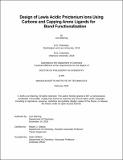Design of Lewis Acidic Pnictenium Ions Using Carbone and Capping Arene Ligands for Bond Functionalization
Author(s)
Warring, Levi
DownloadThesis PDF (13.14Mb)
Advisor
Gilliard, Robert J.
Terms of use
Metadata
Show full item recordAbstract
Interest in the chemistry of antimony and bismuth is rapidly growing due to isolation of low coordinate, subvalent or Lewis acidic compounds that can mediate reactivity traditionally reserved for their d block counterparts. Ligand strategies play a key role in the isolation of such species. Anionic ligands with large steric profiles, as well as carbenes, have been widely implemented to stabilize subvalent heavy group 15 element compounds. However, synthetic strategies to prepare Lewis acidic antimony and bismuth complexes remain underexplored. Cationization is one of the most common methods used to enhance the Lewis acidity of heavy group 15 elements by creating a vacant p orbital on the pnictogen atom. Lewis acids are also employed in frustrated Lewis pair (FLP) chemistry to enable intra- and intermolecular reactivity. Carbone ligands, which are neutral, 4 electron donor ligands, offer a unique ability to support highly electrophilic main-group elements. This dissertation investigates the stabilization of heavy pnictenium ions using neutral donor ligands, such as carbodicarbenes and capping arene ligands, and explores their potential in Lewis acid-mediated chemistry. In Chapter Two, the synthesis and characterization of a series carbodicarbene-pnictenium ions is described. The utilization of strongly donating carbodicarbene ligands enables the isolation of mono-, di- and tri-cationic antimony and bismuth cations. These ions have multiple bond character between carbon and antimony/bismuth, representing some of the first examples of stibaalkene and bismaalkene cationic compounds. The Lewis acidity of these ions was assessed using the Gutmann-Beckett method and computationally derived fluoride ion affinities, the latter of which indicates Lewis superacidity for the bis(pyridyl)carbodicarbene-pnictenium trications. In Chapter Three, the reactivity of the bis(pyridyl)-carbodicarbene stibenium trication toward C(sp³)–H and C(sp)–H bonds is demonstrated. The Lewis superacidic antimony cation mimics the chemistry of frustrated Lewis pairs in the presence of the sterically encumbered base 2,6-di-tert-butylpyridine to enable C–H bond breaking of acetonitrile and a set of terminal alkynes. Kinetic analyses, in conjunction with density functional theory, support a mechanism by which acetonitrile coordinates to antimony, acidifying the C–H bonds, which can be subsequently deprotonated by the base in solution. The resulting stiba-methylene nitrile and stiba-alkynyl adducts undergo reactivity with elemental iodine to generate iodoacetonitrile and 1-iodoalkynes while reforming a stibenium trication. In Chapter Four, capping arene ligands are coordinated to antimony and bismuth tribromide to afford a series of κ²-bound complexes. Bromide abstraction from these neutral adducts affords ionic compounds. Both the neutral and ionic species have distinctive Menschutkin interactions, whereby the lone pair on the pnictogen atom is oriented toward the π system of the pendant arene. Shortening of the distances between the pyridyl nitrogen atoms and pnictogen atom are observed upon cationization from the neutral adducts. The Lewis acidity of these complexes was assessed using the Gutmann-Beckett method. Notably, acceptor numbers as high as 111 are observed for these ions.
Date issued
2025-02Department
Massachusetts Institute of Technology. Department of ChemistryPublisher
Massachusetts Institute of Technology